10 Classic Pyrex Patterns That Every Collector Should Own
If you are a collector of vintage kitchenware, Pyrex should be at the top of your list. The patterns Pyrex created over the years are not only beautiful but also represent an important part of American design. Collecting these pieces allows you to own a piece of history while enjoying their practical use. These patterns, often colorful and full of character, have made their way into homes across generations. As you build your collection, these classic designs will surely stand out.
This post may contain affiliate links, which helps keep this content free. Please read our disclosure for more info.
Primary Colors (1940s-1960s)
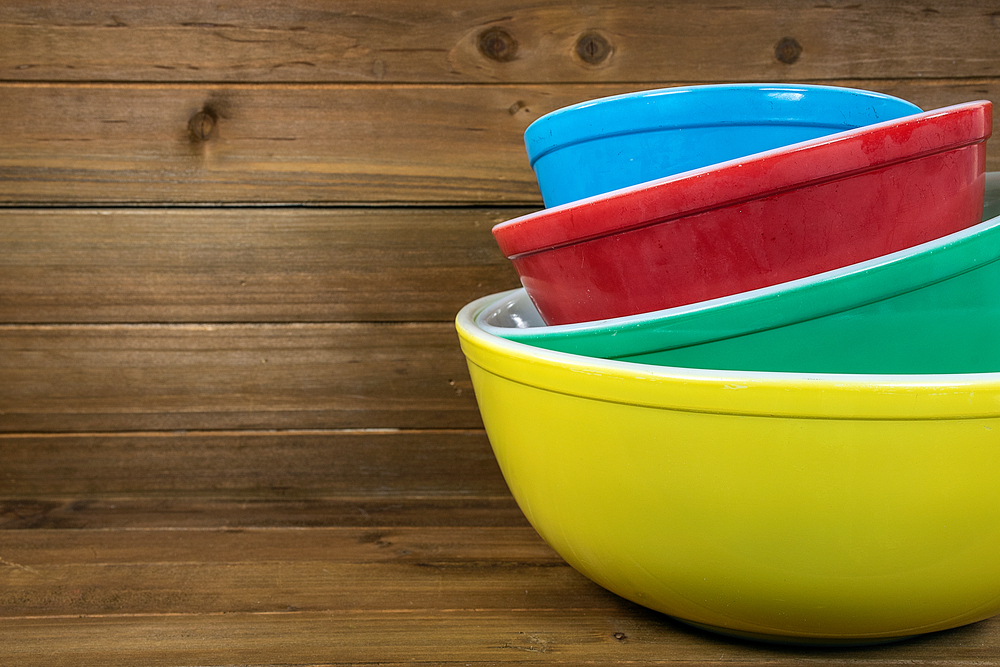
The Primary Colors pattern is one of Pyrex’s most iconic designs, featuring bright red, yellow, and blue colors on a white background. Produced between the 1940s and 1960s, this pattern was designed to appeal to mid-century American families. The simple yet vibrant colors make it a perfect choice for collectors today. Depending on condition and the specific piece, the market value can range from $50 to $200.
The Primary Colors pattern was meant for daily use, making it both practical and decorative. It was originally featured on mixing bowls, which are the most common pieces found today. Collectors appreciate the simplicity and boldness of the design. The enduring popularity of this pattern continues to make it a must-have in any collection.
Snowflake Blue (1959-1961)
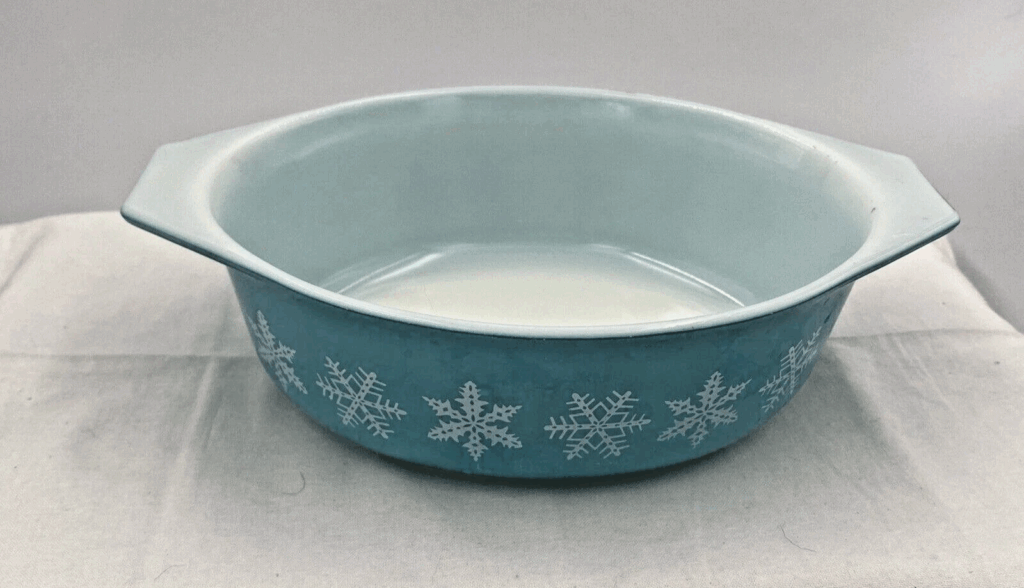
Snowflake Blue, produced between 1959 and 1961, is another highly desirable Pyrex pattern. Featuring small white snowflakes scattered across a soft blue background, it evokes the winter season and the spirit of the holidays. The design is simple yet striking, making it a collector’s favorite for both its aesthetic and nostalgia. Market prices for Snowflake Blue range from $50 to $250, depending on the piece.
The Snowflake Blue pattern was often used on mixing bowls, casseroles, and storage containers. Its appeal lies in its charming winter motif and soothing color. It is one of Pyrex’s most recognized and popular patterns among collectors today. Due to its brief production period, Snowflake Blue is a rare find in good condition, making it a valuable piece in any collection.
Verde (1969-1970s)

The Verde pattern, introduced in 1969, is a stunning deep green color with floral motifs. Its elegant, clean design made it a popular choice in the 1970s, especially for holiday gatherings and family meals. The pattern was primarily featured on mixing bowls, but it also appeared on other types of Pyrex pieces. Collectors can expect to pay between $75 and $250 for well-preserved Verde pieces.
Verde’s dark green color and delicate floral design make it an appealing pattern for those who love vintage kitchenware. The set’s versatility and beauty continue to make it an attractive addition to any collection. As a mid-century design, it is beloved for its simple yet graceful appeal. The popularity of Verde makes it a valuable find for those looking to expand their Pyrex collection.
Pink (1957-1960)

The Pyrex Pink pattern, produced between 1957 and 1960, features soft pastel pink hues and was originally introduced for mixing bowls. It is often adorned with white or silver accents, making it an elegant and timeless piece. The light pink color adds a vintage charm, making it especially popular with collectors seeking pieces from the mid-century period. Pink pieces typically range in value from $50 to $300.
The Pink pattern is a favorite for collectors due to its delicate appearance and association with the glamour of the 1950s. It was a popular design for both everyday use and special occasions, especially for weddings or other celebrations. Today, its soft pastel tone and simplicity continue to make it highly sought after. Whether in mixing bowls or baking dishes, the Pyrex Pink pattern remains a cherished design.
Butterprint (1957-1960)
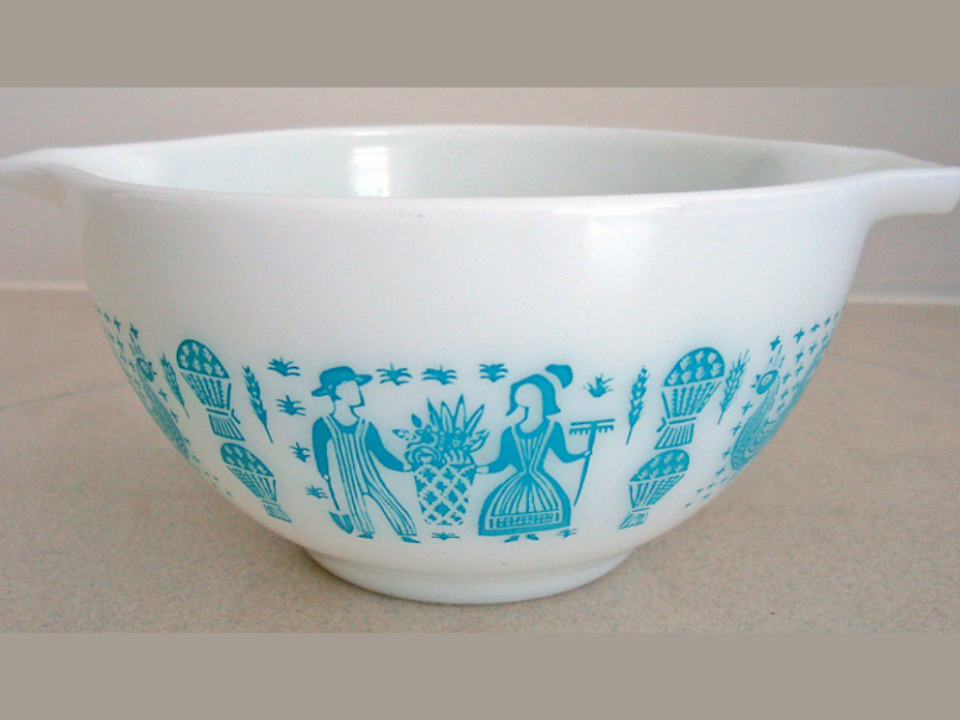
The Butterprint pattern was introduced in 1957 and quickly became a favorite among Pyrex enthusiasts. It features a whimsical, soft green design of farm scenes, including roosters and wheat sheaves, against a white background. The design was initially applied to mixing bowls and casseroles, making it functional for everyday use. Depending on the condition, Butterprint pieces can be valued from $60 to $300.
This pattern evokes nostalgia for the simpler times of rural America, with its vintage charm and delicate detailing. The green color adds a soft, earthy touch to the kitchen, making it a versatile and beloved pattern. It remains one of the most sought-after designs in the Pyrex collection. Collectors continue to search for the Butterprint design, especially in well-preserved condition.
Atomic Starburst (1950s-1960s)
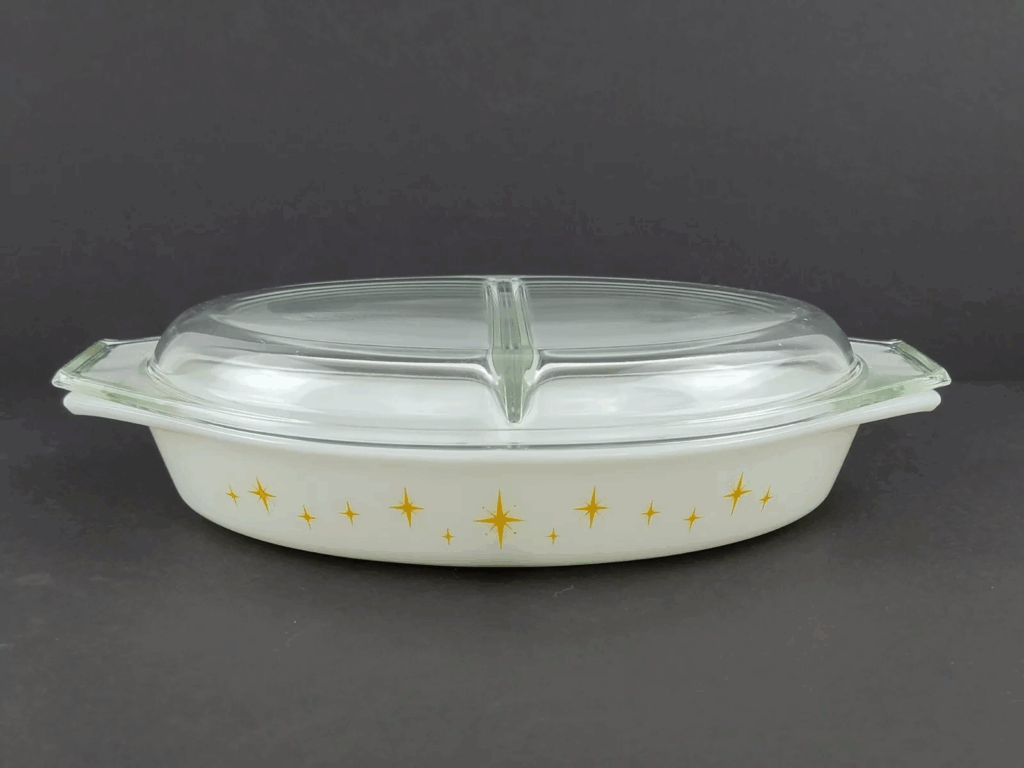
The Atomic Starburst pattern was a popular design in the 1950s and 1960s, reflecting the space-age optimism of the time. It features starburst shapes in vibrant colors, often on a white background, which gives it a bold, modern look. The Atomic Starburst design was applied to a variety of pieces, including mixing bowls and casseroles. Prices for this pattern typically range from $100 to $350, depending on the piece and condition.
The Atomic Starburst pattern captures the excitement of the 1950s and 1960s, making it a popular collectible item. Its futuristic design and lively colors make it stand out in any Pyrex collection. This pattern’s popularity continues to grow, particularly among collectors of mid-century modern items. The rarity of specific pieces and the appeal of the design ensure that Atomic Starburst remains a high-value item.
Gooseberry (1957-1961)
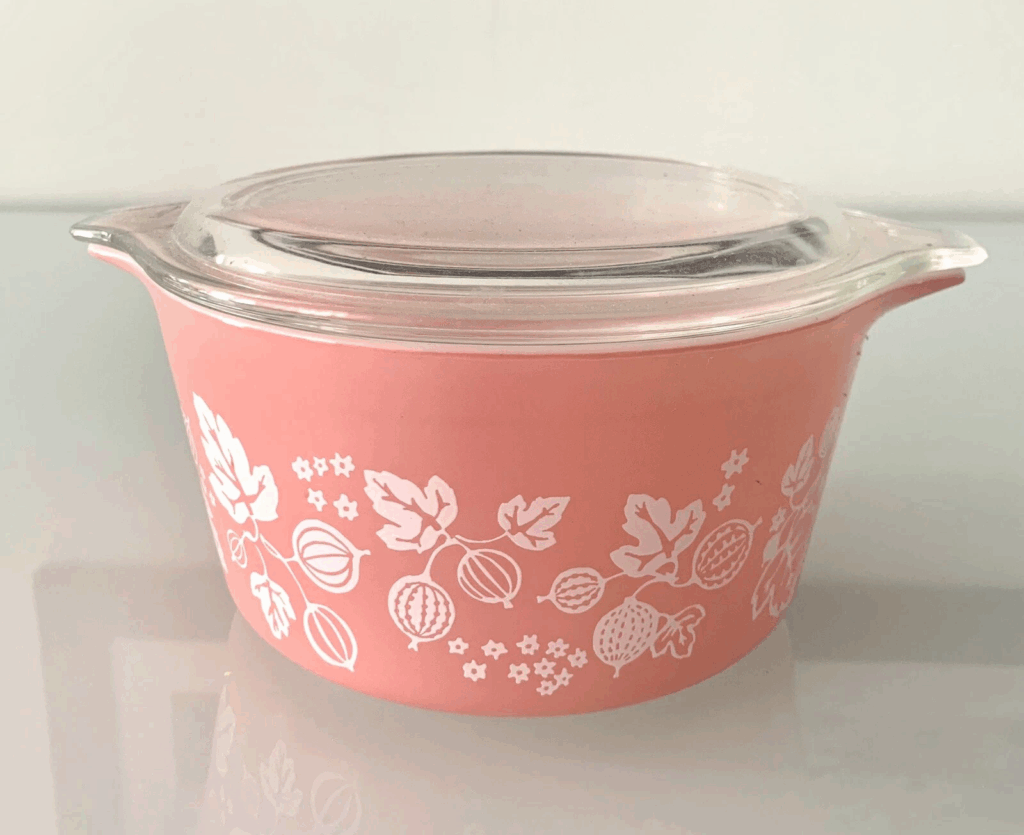
The Gooseberry pattern was produced by Pyrex from 1957 to 1961 and features delicate grapevine designs in soft pink, white, or blue. The pattern is often seen on mixing bowls, but it was also used on other Pyrex pieces. Gooseberry pieces are highly valued today, with prices ranging from $75 to $350 depending on size and condition.
The graceful grapevine design on Gooseberry pieces gives them an elegant and timeless appearance. The soft pastel colors make it a versatile choice for collectors who appreciate subtle vintage designs. As one of Pyrex’s most beloved patterns, it holds a special place in the hearts of collectors. Its continued popularity ensures it remains a highly sought-after pattern in the Pyrex world.
Turquoise (1957-1960)
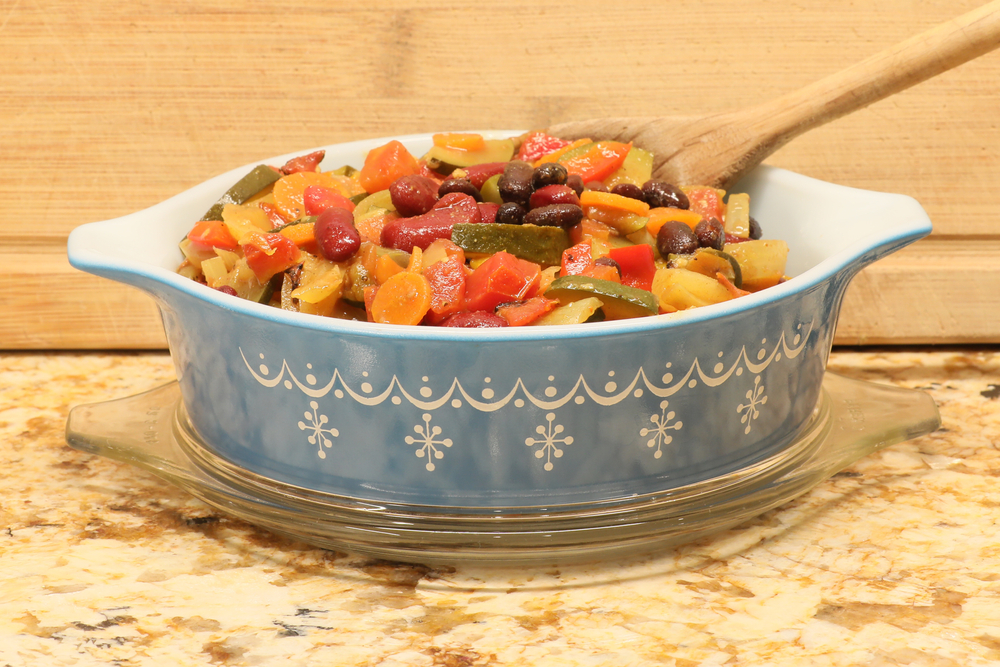
The Turquoise pattern, introduced in the late 1950s, features a soft, rich turquoise color that became a signature design for Pyrex. Often paired with white accents or simple floral motifs, this pattern is both striking and simple. Turquoise pieces are especially valued for their vibrant color and timeless appeal. Depending on condition, these pieces can be valued from $75 to $300.
This pattern was widely popular in the 1950s and 1960s, adding a bright and cheerful touch to kitchens. The clean design and subtle charm make it highly collectible. Turquoise Pyrex continues to be a favorite for those who enjoy vintage kitchenware. Its ongoing popularity among collectors ensures its high market value.
Spring Blossom Green (1972-1977)
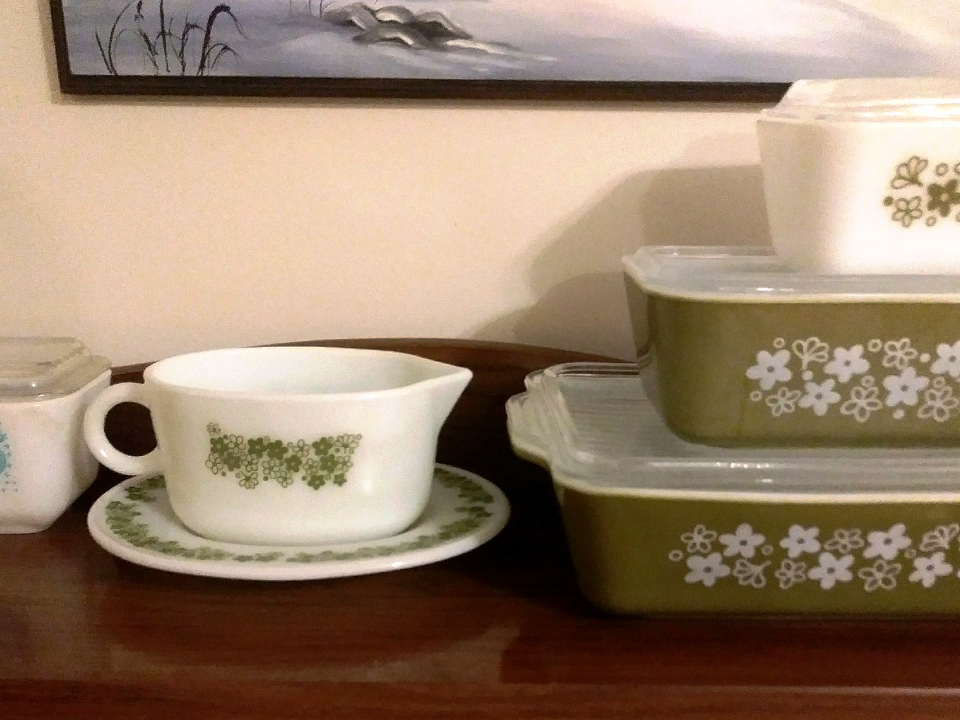
Spring Blossom Green, produced between 1972 and 1977, features a soft floral pattern in shades of green on a white background. This charming design was featured on a variety of Pyrex products, including mixing bowls, casserole dishes, and mugs. Spring Blossom Green pieces are valued between $50 and $250, with well-preserved items fetching higher prices.
This pattern evokes a sense of freshness and warmth, making it an enduring favorite. The simple floral design captures the spirit of the 1970s, appealing to collectors who appreciate the vintage charm of this era. Its continued popularity ensures it is a valuable piece for any Pyrex collection. Collectors continue to seek out Spring Blossom Green pieces for their timeless beauty.
Cherry (1950s-1960s)
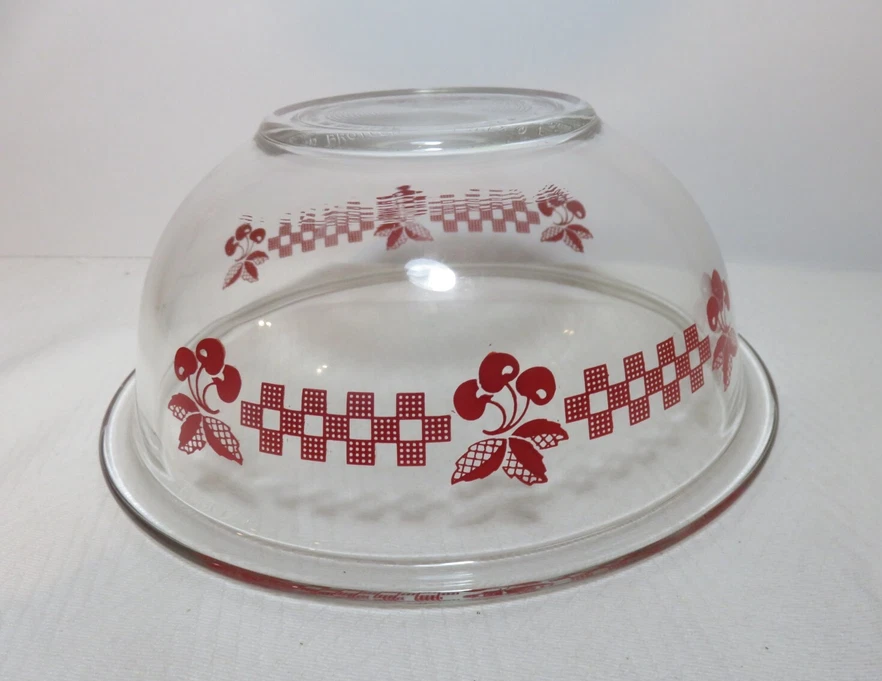
The Cherry pattern, produced in the 1950s and 1960s, features a bright red cherry motif on a white background. It was designed to bring a pop of color to the kitchen, and the bold design quickly became a favorite among Pyrex enthusiasts. Today, Cherry pieces can range in value from $75 to $350, with some rarer pieces selling for more.
The playful cherry design remains one of the most recognizable Pyrex patterns, especially on mixing bowls and serving dishes. The bright red color adds a cheerful touch, making it a popular choice for vintage kitchenware collectors. Its bold and simple design makes it both timeless and functional. The demand for Cherry-pattern Pyrex ensures its place as a high-value item in the collector’s market.
The timeless patterns continue to be highly valued for their aesthetic and practical uses. Collectors appreciate the craftsmanship and simplicity that these pieces offer, making them worthy additions to any collection.
This article originally appeared on Avocadu.
